ISPO An Asian Prosthetics and Orthotics Workshop '98 in Japan Final Report
| Contents | | Photos | | Previous Page | | Next Page |
EXPERIENCE AND STRATEGY AT THE TANZANIA TRAINING CENTRE FOR ORTHOPAEDIC TECHNOLOGISTS (TATCOT):
Introduction
Training and education in any profession is a continuous process in which one updates and improves the quality of services to be offered. It enables individuals to improve the quality of services in their respective areas of interest. In a profession where the attitude, knowledge and skills are the key factors in achieving the desired quality of service, a continuous programme of training and education becomes necessary.
The principle of maintaining as well as assuring quality, quantity and service delivery in the field of technical orthopaedics will ensure the best rehabilitation of persons with physical disabilities with the aim of re-alignment of the musculo-skeletal system and of attaining optimum body posture and gait pattern.
Different education and training programmes have been developed and introduced to meet the various specific needs in this field. These programmes are long term (1-4yrs), short term (1-6months) and tailor made courses.
Orthopaedic Technologist Course at "TATCOT"
The Tanzania Training Centre for Orthopaedic Technologists (TATCOT) was founded in June, 1981 with the main objective of upgrading and increasing the number of professionals equipped with adequate knowledge to serve persons with neuro-musculo-skeletal deficiencies. As the years went by the school extended its enrolment of students not only from East Africa but also from various other English speaking African countries.
In the mid 1980's the school realised the need of incorporating its programme under the University of Dar-Es-Salaam. This gives the qualifying professionals a better chance to be recognised, a clear path for academic as well as professional development and greater suitability for the service in their respective countries.
One of the first well structured training programmes in Prosthetics and Orthotics was established in Tunis, 1966 followed by Togo, Lome (1976) and Moshi, Tanzania (1980). The courses offered in these centres were structured so as to produce an Orthopaedic Technologist, capable of independently managing an Orthopaedic Workshop, participating as a full member of an Orthopaedic Clinic Team and fabricating different types of prosthesis and orthosis.
Up to late 1960's the Prosthetic and Orthotics services were provided by technicians who had very little background in the profession. These were bench workers who had attended informal in-service training or short term courses organised by various donor organisations in Africa and Latin America. Indeed the achievements of these training programmes are to be admired as they produced technicians who could fabricate simple calipers and peg legs for poliomyelitis victims and amputees who needed immediate rehabilitative measures.
Training Programmes Offered at TATCOT
The School offers the following education and training programmes:
- three year Diploma Course in Orthopaedic Technology,
- one year Certificate Course in Lower Limb Orthotics or Prosthetics, a short term tailored programmes on specific areas identified by the trainees,
- national and regional seminars or workshops on specific subjects related to prosthetics and orthotics,
- short term consultancy on education and training.
Three Year Diploma Course In Orthopaedic Technology:
First year:
During the first year of study the students are trained in the relevant theoretical and practical subjects. There is particular emphasis on metalwork technology as well as Orthotics related practical knowledge and skills as shown (Fig.1).
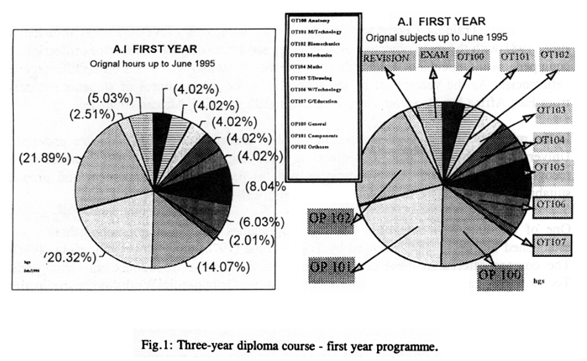
Second year:
During the second year of study the students are trained in the relevant theoretical and practical subjects. As can be seen (Fig.2), there is more emphasis on woodwork technology as well as prosthetics related practical knowledge and skills.
Third year:
During the third year of study the students are trained in the relevant theoretical and practical subjects. The students are engaged in clinical work throughout the year. Each student must fit a specific number of prosthetic and orthotic patients to qualify to sit the final examination.
One Year Certificate Course in Lower Limb Orthotic or Prosthetic Technology (LLOT or LLPT)
The one-year certificate course comprises both Orthotic and Prosthetics Practice. During this period of study the students are trained in relevant theoretical and practical subjects. As shown (Fig.4), the students are engaged in clinical work throughout the year whereby a specific number of prosthetic and orthotic patients have to be fitted before they can qualify to sit for the final examination. The training is completed in each of which includes an examination.
Short Term Tailored Programmes
In orthopaedic technology, one of the most effective training and education programmes is that which is provided within the working environment, i.e. in-service training or tailor made programmes. Due to the periodic outbreak of civil wars, lack of security, and previous lack of essential facilities, the present staff has not been effectively engaged in the prosthetic and orthotics practice.
The school has introduced short term training programmes which are either offered at the Centre or are carried out within the student's rehabilitation facility according to the need. An example of such a course, was held at TATCOT for a group of student from Bulongwa Lutheran Hospital, Iringa, Tanzania.
The main objectives of the short term training course were:
- to update and upgrade the knowledge and skills of orthopaedic technical professionals through a theoretical and practical structured course
- to develop skills in the organising and co-ordinating orthopaedic technical services using a rehabilitation clinical team approach (RCTA).
- to advise and educate the professionals on the concept of implementing a community based rehabilitation (CBR) programme through satellite orthopaedic workshops which are centrally co-ordinated.
Training Strategies and Achievements at TATCOT
Since the inception of TATCOT, the Centre has embarked on several activities in the area of education and training within and outside the region. Among others the following are the achievements made:
- The school has continued receiving an average of 13 students per academic year (Fig.5) from within and outside the country.
- When the school was initially set up, the aim was to have a training centre which would be self sustaining. It was anticipated that 65 % (foreigners) of the students should pay the full costs of training while 25 % (Tanzanians) should be sponsored by the government, which contributes 30% of the annual budget in the form of human resources and recurrent funds.
Although the school has maintained the average intake of students, the number of candidates joining TATCOT per year has not been stable due mainly to the following reasons:
- at least 15 % of the candidates selected to join the school do not fulfil the entry requirements.
- at least 35 % of the students qualified to join the school do not acquire sponsorship for reasons such as conflicting priorities in the health sector, bureaucratic difficulties or favouritism in their respective countries.
When the cost of training each student was revised in June 1996, it was realised that the school could not afford to take more than 25 % of the Tanzanian government sponsored students. At present the distribution of student intake is therefore 75 % foreign students and 25 % Tanzanian students.
Category II professionals (orthopaedic technologists) have become widely distributed over the region. There are, on average, of 13 students per academic year. The percentages of orthopaedic technologists from different African countries who have qualified at TATCOT are as indicated in Fig.6.
Short term training programmes in "Lower Limb Orthotics or Prosthetic Technology" (LLOT or LLPT)
In June 1990, the World Health Organisation and the International Society for Prosthetics and Orthotics met in Alexandria and discussed the need for introducing an alternative short term training programme in either Lower Limb Orthotics or Prosthetics. The main aims were:
- to produce many technicians specialising in either orthotics or prosthetics within as short a time as possible,
- to offer opportunities of upgrading courses for assistants already practising in the field of prosthetics and orthotics,
- to elevate the qualification of the assistant to that of qualified orthopaedic technologist (Category II),
- to have technicians capable of producing components locally.
As a result of the recommendations made in that meeting, a curriculum was developed by TATCOT in collaboration with ISPO and WHO. The course in Lower Limb Orthotics and Prosthetic started in October 1993. To date a total of 23 lower limb orthotics and prosthetics technologists have successfully completed this course with a distribution as indicated (Fig.7). The school continues to promote and encourage developments in this programme so that human resources may be better able to meet the enormous demand at the community level.
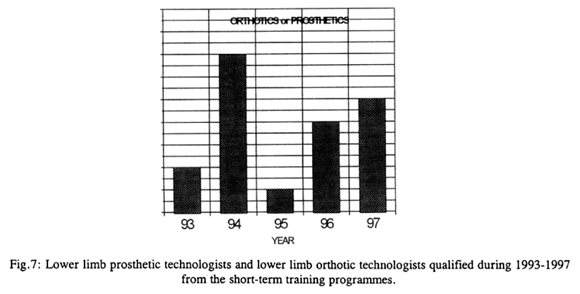
On average seven students join each one-year certificate course in Lower Limb Orthotics or Prosthetics Technology. It is important to note the positive response from different countries in the region (Fig.8). The large number of candidates from Eritrea joining the one-year course was due to the urgent rehabilitation needs of the disabled population as a result of civil war.
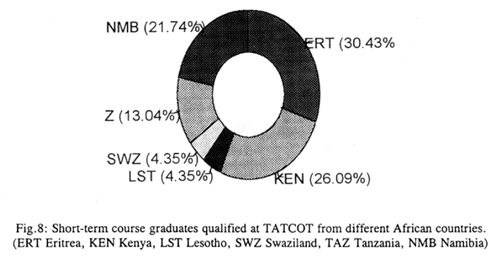
Many bench workers who had not attended a formal training programme have undergone in-service training for a recognised qualification. The school has given lowly trained individuals the chance to pursue the three years diploma training programme so as to elevate their professional knowledge, skills and attitude. Out of the 186 orthopaedic technologists qualified at TATCOT, 34% had already been working in the profession. However, it is important to note that most of them appreciated the tremendous gain in their clinical competence in the prosthetic/orthotic management of persons with physical disabilities. Reports received combined with physical visits to many of the orthopaedic technical facilities have shown a positive improvement in both management and techniques of fabricating orthopaedic appliances. This has also stimulated interest amongst the other lowly trained persons to seek advancement in the profession through acquiring knowledge and skills.
Distribution of Personnel and orthopaedic workshops which are co-ordinated and advised by TATCOT in Tanzania.
As of June 1986, Tanzania had 23 orthopaedic workshops which were owned by either the government or non-government organisations. Of these, 13 workshops had strong consultancy links with the school and efforts are still being made to develop contacts with the rest. These workshops are located as indicated (Fig.9) depending on their capacity and size, within the following categories:
- Consultant Orthopaedic Workshops
- Regional Orthopaedic Workshops
- District Orthopaedic Workshops
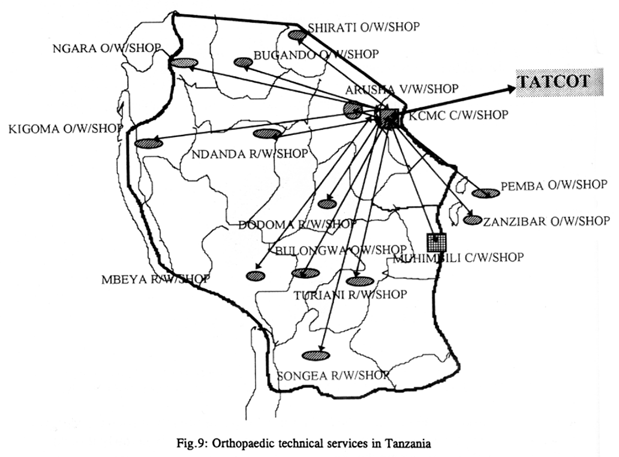
During the past 15 years the school has developed close co-operation in the areas of training and service delivery with many countries. This co-operation has enabled the school to gather experience in areas which need to be looked at in the three and one year curricula as well as planning for courses which are of interest to the major group of professionals currently practising in those countries.
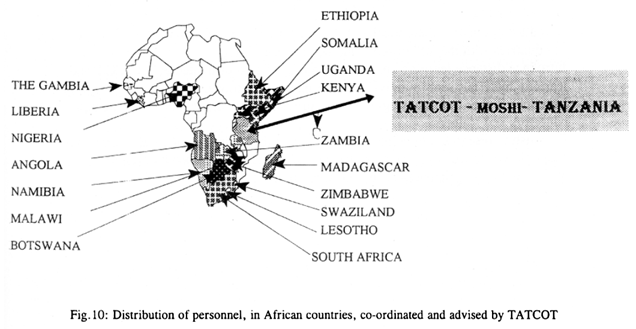
Fig. 10 indicates countries with which TATCOT has had contacts and co-operation in all areas of service delivery as well as training and education.
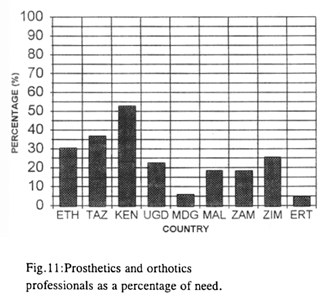
Fig.11 indicates the achieved human resources in the field of prosthetics and orthotics in some sampled countries. it can be seen that the need for training is extremely high. It is, therefore, necessary to:
- think of introducing additional training programmes which will increase the number in the near future.
- expand capacity and increase the number of professionals
- introduce more alternative training programmes
- develop more awareness and give more priority to countries such as Madagascar, Zambia, Eritrea, Uganda, Ethiopia and Tanzania.
Future Development Strategies at "TATCOT"
Looking into the facts expressed earlier on, the school has started outlining the following activities in which it has to embark on in future:
- Reinforce the short term training programmes for bench workers and lowly trained human resources.
- Introduce alternative theoretical and practical training programmes in different centres or countries with the aim of reducing the cost of training.
- Introduce distance learning courses which could be co-ordinated at TATCOT and learning materials sent to individuals and interested groups.
- Introduce higher training programmes to provide more highly qualified clinicians, educators and trainers.
- Establish a research unit which would facilitate the utilisation of local resources, adaptation of technology and scientific testing of orthopaedic products to ensure the quality and appropriateness of the services provided.
Commemorating the Mid-Point of Asia and Pacific Decade of Disabled Persons
ISPO An Asian Prosthetics and Orthotics Workshop '98 in Japan Final Report
- Papers : Experience and Strategy in Tanzania Training Centre for Orthopaedic Technology (TATCOT) -
Editors:
Eiji Tazawa
Brendan McHugh
